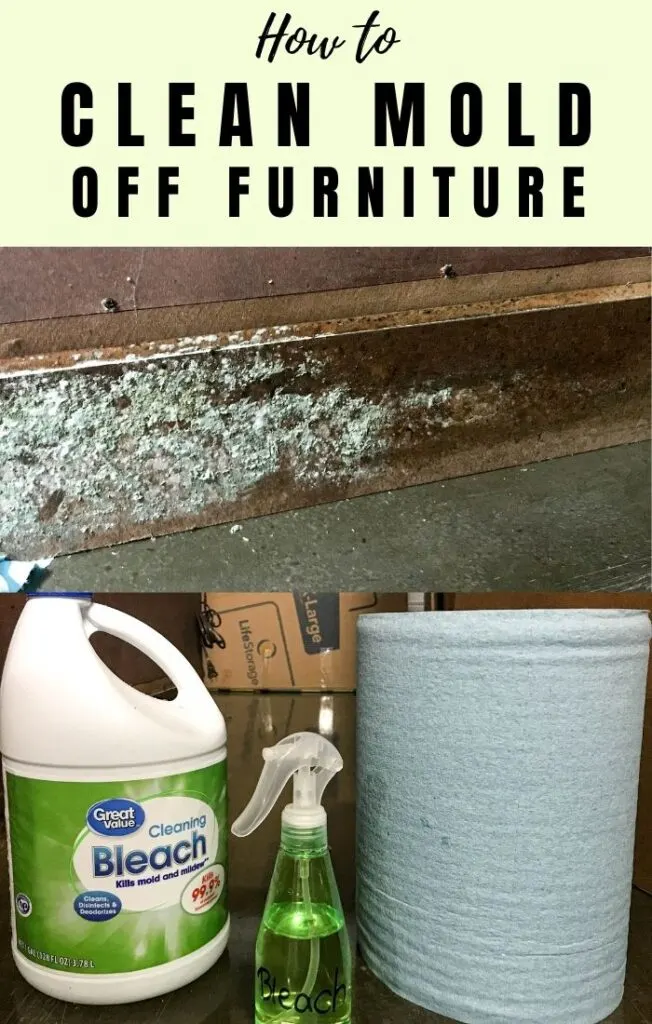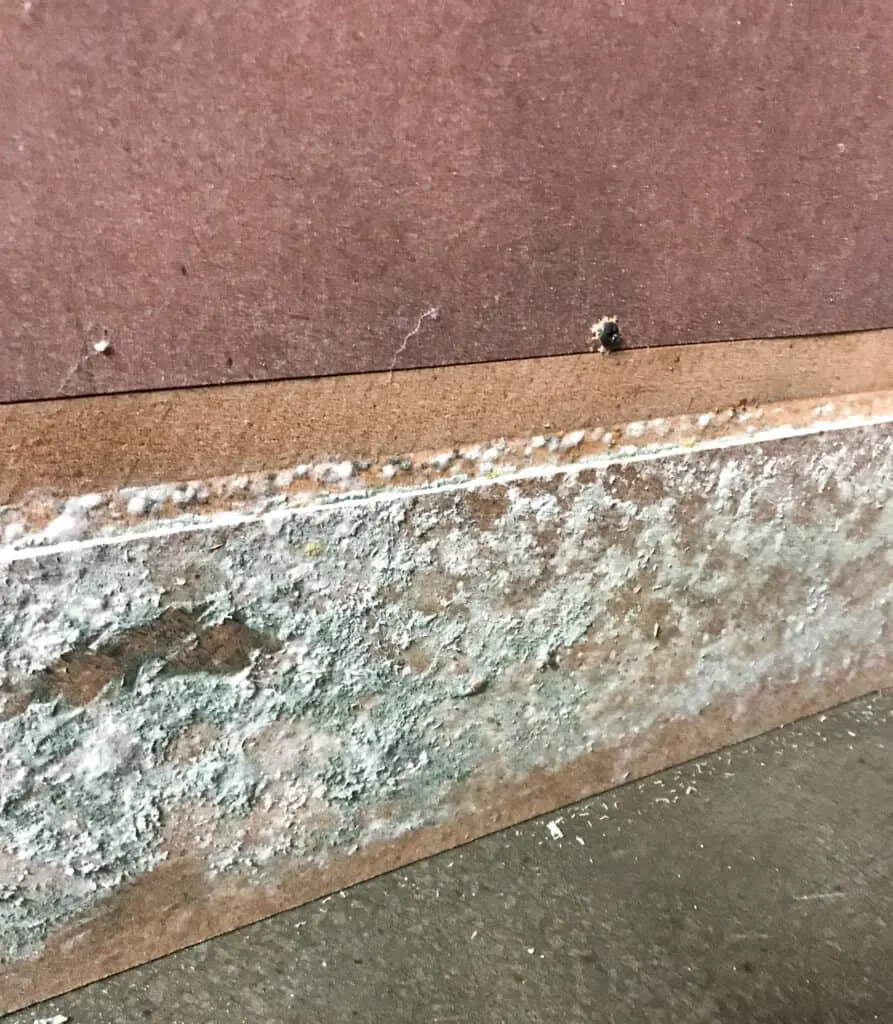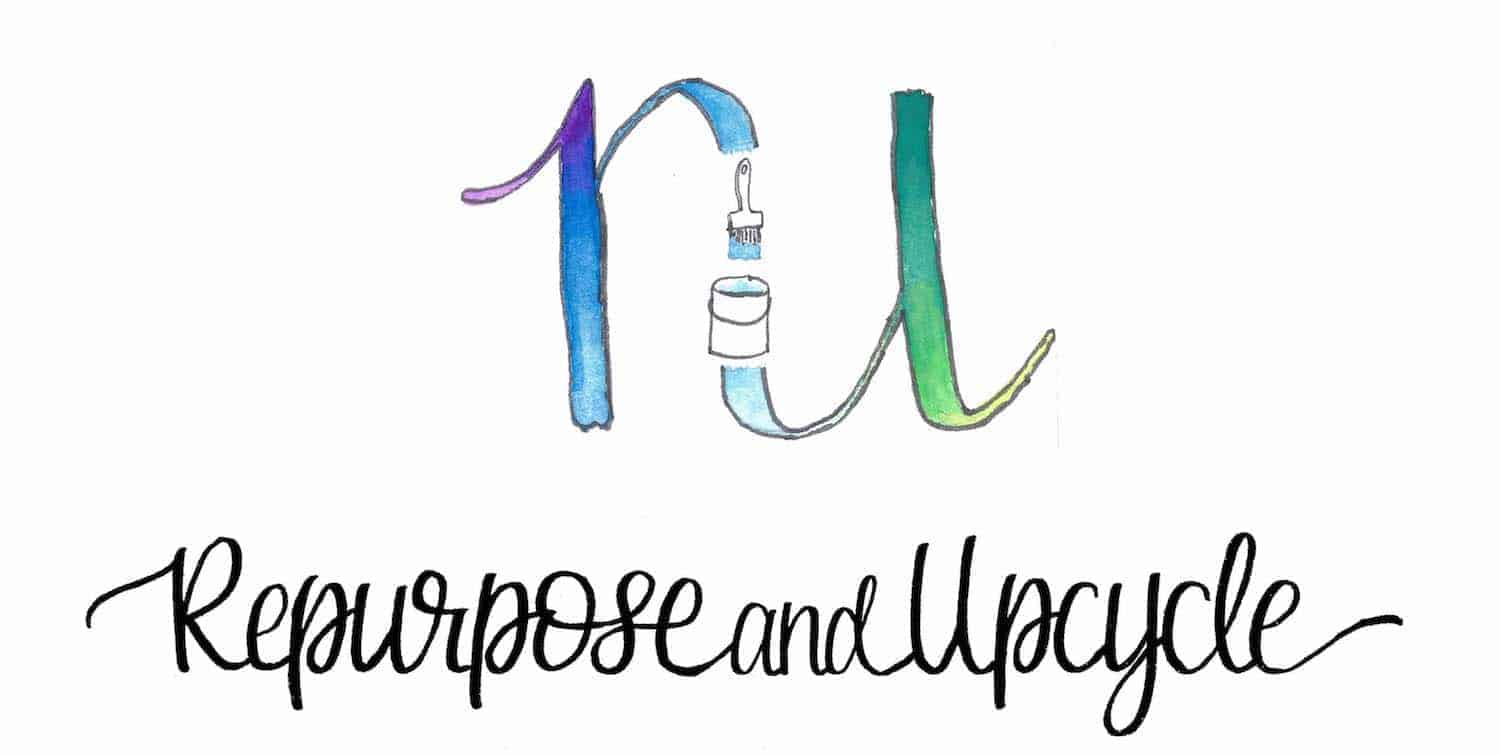Mold growth; it’s a nasty thing. Especially on beautiful solid wood furniture. It all started after Hurricane Sally. Our little town was devastated after this very strong and unexpected hurricane hit. Even though my home did not sustain much damage, my mother and father in law were not so lucky. Needless to say their entire home flooded and all their solid wood furniture ended up sitting in flood water.
Long story short, after a few short days most of it ended up with nasty mold on the bottom. This is the story of how we successfully removed mold and prevented mold growth on their beautiful solid wood furniture.
Mold is a common problem in many homes, and it can be particularly difficult to remove from wood surfaces. When left untreated, mold can cause serious health problems and damage to the wood itself. Fortunately, there are several effective methods for removing mold from wood surfaces.

The first step in removing mold from wood is to identify the source of the problem. Mold can grow on wood surfaces that are damp or have been exposed to moisture, so it’s important to address any underlying moisture issues before attempting to remove the mold. Once the source of the problem has been addressed, there are several methods for removing the mold itself.
One effective method for removing mold from wood is to use a solution of bleach and water. This solution can be applied to the affected area using a sponge or spray bottle, and then allowed to sit for several minutes before being wiped away with a clean, damp cloth. It’s important to wear gloves and protective eyewear when working with bleach, and to ensure that the area is well-ventilated.
Make sure to also check out my post on the Best Mold Removal Products from Amazon. I do wish I had a few of these products when I was cleaning up the mold growth after the hurricane.

Table of Contents
Understanding Mold on Wood
What is mold?
Mold is a type of fungus that grows in damp and humid conditions. It can appear as black, green, or white patches on wood surfaces. Mold spores are airborne, and they can easily spread and grow on other surfaces if left untreated.
Web MD states “Mold is a type of fungus. These small organisms can be black, white, orange, green, or purple and live almost anywhere indoors and outside. Molds thrive on moisture and reproduce through lightweight spores that travel through the air.”
If mold isn’t properly removed, it can spread to everything it’s around since it spreads through the air.
It’s important to understand that mold reproduces and spreads through the air.
Why is this important?
Chances are if there is mold growth on one piece of furniture and it’s stuffed in a storage unit with other furniture, within weeks the mold spores have probably spread.
Why does mold grow on wood?
Wood is an organic material that provides a suitable environment for mold to grow. Mold grows on wood when it is exposed to moisture for an extended period. This can happen due to water leaks, high humidity, poor ventilation or a hurricane. 🙁
What are the dangers of mold on wood?
Mold on wood can cause several health problems, including allergies, asthma, and respiratory issues. It can also weaken the structure of the wood and cause it to rot. If left untreated, mold on wood can spread to other areas of the house and cause significant damage.
Preparing for Mold Removal
Gathering Materials
To effectively remove mold from wood, you’ll need a few essential materials. These include:
- Protective gear such as gloves, goggles, and a respirator mask
- Cleaning solution specifically designed for mold removal
- Scrub brush or sponge
- Sandpaper or a sanding block
- Plastic sheeting or tape to seal off the area
Protecting Yourself and Your Home
Mold spores can be harmful to your health, so it’s important to take precautions to protect yourself during the removal process. Be sure to wear protective gear such as gloves, goggles, and a respirator mask to prevent inhalation of mold spores and exposure to cleaning chemicals.
To prevent the spread of mold spores, it’s also important to seal off the area where you’ll be working. Cover any vents or openings with plastic sheeting or tape to prevent spores from spreading to other areas of your home.
In addition, be sure to dispose of any materials that have come into contact with mold, such as rags or sponges, in a sealed plastic bag. This will prevent spores from spreading to other areas of your home during disposal.
By taking these precautions and properly preparing for mold removal, you can effectively remove mold from wood and protect yourself and your home from harmful spores.
I mentioned that my in laws had mold growth on the bottom of most of their wood furniture. What I didn’t mention is that they had to unexpectedly move out (which meant hiring movers on a whim to take everything to a storage unit) and they did not get to properly clean the things that got wet.
Disclosure; this post contains affiliate links. As an Amazon Associate I earn from qualifying purchases. This does not affect the price you pay. This disclosure statement refers to the rest of the amazon links and other affiliate links in this post.
When we opened up the storage unit after a few months this is what we found on the bottom of a few of the big furniture pieces.

You can see exactly where the water line was.
Look at all that mold growth!
So now what?
How to clean mold off wood
- Make sure to wear protective clothing and gloves
- Make sure the surface is dry (and has been dry for at least 2 days)
- It’s best to move everything outside in the sun before you begin to clean
- Spray a non ammonia cleaner on the surface and rinse with hot water. Use a stiff brush if you need to scrub mold away
- Remove the water with a Shop vac
- Mix a 10% bleach to water mixture and pour in a spray bottle
- Spray a generous amount on the surface AND ABOVE the mold
- Let the solution sit on the surface for 10 minutes
- Rub the surface and watch the mold come off
- Once there is no visible sign of mold, let it sit and dry (in the sun is best)
Fema has a great brochure on how to get mold out of furniture and other surfaces.
Let me show you what it looked like when we started to remove the mold and spray the bleach solution.
Mold cleaning solution
The ammonia free cleaner I used was what I had on hand in our kitchen. I sprayed it and then washed it off with hot water.
Then I used a 10% bleach solution with bleach and water. There are other products on the market that you can buy that are made specifically for killing and preventing mold if you prefer not to use bleach. Concrobium is one of these solutions. It also comes in a spray form.



This was the back of a very nice solid wood buffet. You can see the part that got wet was a piece of particle board.
We used the bleach solution to clean it and let it sit and dry outside. Unfortunately, after it was cleaned we could still see a few bits of mold (they call this a mold colony) which means that the fungus had buried in the porous wood.
Since it was the backside of the buffet and only particle board, we opted to remove it.
Tips to remove mold from wood:
- My best tip is this; when in doubt, throw it out.
- It is easier to remove mold from solid wood than porous surfaces like particle board.
- Remember to clean EVERY piece of wood that sat near the mold with a bleach solution (since mold spores spread in the air).
- Check back within a few days after the initial cleaning to make sure there are no signs of new growth.
- If you’ve properly cleaned the surface and the mold keeps growing back, chances are the it has burrowed deep in the wood and the furniture piece needs to be discarded.
How to prevent mold growth on furniture
- Keep furniture in a cool dry area with low humidity
- Continue to check for new mold growth
- Keep the wood clean
If you follow all my tips and solutions on how to kill mold off of furniture, hopefully you’ll be able to salvage those beautiful wood pieces!
Doing these few simple steps should help prevent future mold growth.
We had to throw basically all the fabric furniture away but we were able to save all the solid wood pieces. I hope we don’t have to go through a major hurricane like that for at least another 10 years!
Another tip I have is for those of us (ME) that love to thrift old furniture. Because you don’t necessarily know what condition the piece came from or if it ever had previous mold on it, it’s always best to prime the piece with a mold preventing primer before you paint it. See my favorite primers here.
If you don’t plan to paint it, make sure to clean it really well and inspect the wood for mold.
“Mold preventing primers” also help reduce that “stale” smell. See more painting tips and tricks here where I share other painting ideas you might not find elsewhere.
Hope these tips help keep your house healthy and clean!
Lindsey**

Great article! To remove mold from wood furniture and prevent its growth, gently clean it with a mixture of water and mild detergent. Keep the furniture dry, in a well-ventilated area with low humidity. Regularly inspect and clean for moisture. Use dehumidifiers or moisture absorbers to control humidity. Preventive measures ensure mold-free wood furniture.
Hi there I have done mold removal mostly the dreaded black mold and it is the same as all other mold I use a very strong bleach and if it is black mold it will change colors to a tan or orange color do not touch it till it changes colors that’s the way you know it is dead if it doesn’t change color or you clean it off before it changes color it is still very much alive and it will spread and come back for your safety please don’t mess with mold until it changes color
Be safe and be Blessed
Thank you for the advice! This is good to know.